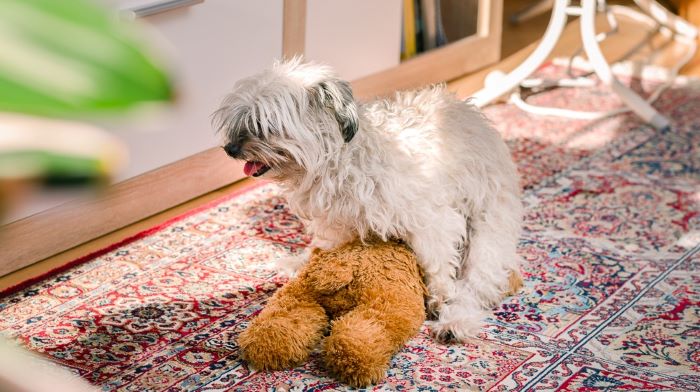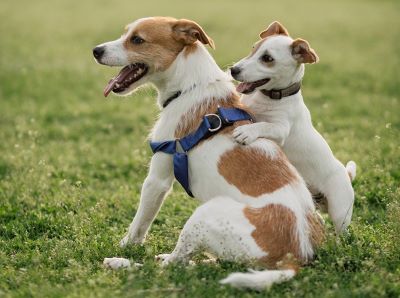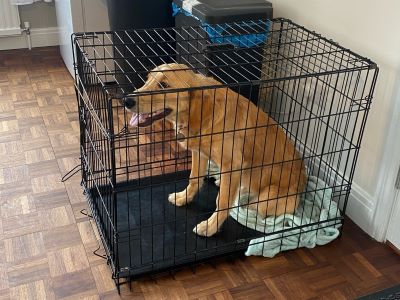Dogs are loyal and loving companions, but sometimes they can show behaviors that are awkward or confusing for us.
- One of these behaviors is sexual excitement, which can make dogs mount, hump, or masturbate in inappropriate situations. How to calm a sexually excited dog?
- While this is natural and normal for dogs, it can also cause problems for us and others who have to deal with it.

In this article, we will learn some effective ways to calm a sexually excited dog and stop them from humping and mounting people, animals, or objects. We will also understand why dogs do this and what triggers their behavior.
By following these tips, we can help our dogs learn to control their urges and behave more properly in different situations. We can also improve our bond with our dogs and make them happier and healthier.
How Do You Calm a Sexually Excited Dog?
If your dog is humping or mounting people, animals, or objects in inappropriate situations, you may wonder how to calm them down and stop their behavior. There are several methods you can try.
In this section, we will explain each method in detail and how to use it effectively.
Method #1: Make a Distracting Noise
One of the simplest ways to stop your dog from humping is to make a loud noise that interrupts and discourages their behavior.[1]
This can be a stern “No!” or a clap of your hands, or any other sound that your dog has learned to associate with unacceptable behavior.
The noise should be loud enough to startle your dog out of their trance, but not so loud that it scares or hurts them.

a). How this method works to calm a sexually exited dog: Making a loud noise works by breaking your dog’s concentration and attention on the sexual stimulus.
It also signals to your dog that you are not pleased with their behavior and that they need to stop.
This method can be effective if you have already established trust and dominance with your dog through training, and if you use it consistently and promptly.
b). When to use this method to calm a sexually exited dog: You can use this method whenever you see your dog starting or in the middle of humping or mounting another dog, person, or object.
It is important to make the noise as soon as possible, and not after the behavior has already occurred. Otherwise, your dog may not understand what they did wrong and may repeat the behavior.
Some examples of noises that can be effective to stop your dog from humping are:
- A loud clap of your hands.
- A whistle or an air horn (make sure they are far enough from your dog’s ears)
- A shake can (a can filled with coins or pebbles that makes a rattling sound)
- A spray bottle with water (spray it near your dog’s face, not directly at them)
- A clicker or a buzzer (if your dog has been trained with them)
Method #2: Channel Your Dog’s Attention
Another way to stop your dog from humping is to use toys, games, or treats to divert their attention from sexual stimuli.
This can be a squeaky toy, a ball, a tug rope, or a tasty snack that your dog loves.
Whenever you see your dog starting to hump, say “off” or “stop” and offer them the toy, game, or treat instead.
Praise your dog when they move their attention to the reward and away from the humping.

a). How this method works to calm a sexually exited dog: Giving your dog a different and appropriate outlet for their enthusiasm, agitation, or tension will help you channel their attention.
They learn from it as well that humping is not a good habit to get into and that giving up on it will lead to greater things.
This strategy can be successful if you do it often, act quickly, and select a reward that is more alluring than the sexual stimulation.
b). When to use this method to calm a sexually exited dog: You may employ this technique each time you notice your dog trying to hump another dog, a human, or an item.
Use it as soon as feasible, not after the conduct has already taken place. Otherwise, your dog could not grasp what they did wrong and repeat the action.
Some examples of activities or items that can be engaging for your dog are:
- Playing fetch with a ball or a frisbee.
- Playing tug-of-war with a rope or a toy.
- Playing hide-and-seek with a treat or a toy.
- Giving your dog a puzzle toy or a Kong filled with peanut butter or cheese.
- Giving your dog a chew toy or a rawhide bone.
Method #3: Remove Your Dog from the Area
Sometimes, the best way to stop your dog from humping is to remove them from the area where they are sexually excited.
This can be a crate, a kennel, a backyard, or another room where your dog can be alone and calm down.
Say “off” or “stop” and lead your dog away from the sexual stimulus. Leave your dog in the isolated area for a few minutes until they are calm.
Make sure there are no toys or objects that your dog can hump in the area.

a). How this method works to calm a sexually exited dog: By physically isolating your dog from the sexual stimulation and dissuading them from engaging in the activity again, removing your dog from the location works.
Also, it teaches them that humping is unacceptable and that engaging in social contact would be restricted if they do.
This approach could work if you use it frequently, quickly, and make sure your dog is calm before releasing them.
b). When to use this method to calm a sexually exited dog: If previous techniques haven’t worked to stop your dog from humping another dog, a person, or an object, try this one.
It is crucial to utilize it as soon as the behavior starts, not after it has already happened. If not, your dog could not comprehend what they did incorrectly and might repeat the action.
Some examples of situations where removing your dog from the area is appropriate are:
- When your dog is humping a visitor or a stranger.
- When your dog is humping another dog that does not like it or may react aggressively.
- When your dog is humping an object that belongs to you or someone else.
- When your dog is humping excessively or compulsively.
Method #4: Get Your Dog Spayed or Neutered
One of the most effective ways to reduce sex hormones and sexual behaviors in your dog is to get them spayed or neutered.
Spaying is the surgical removal of the ovaries and uterus in female dogs, while neutering is the surgical removal of the testicles in male dogs.[2]
Spaying or neutering your dog can decrease their urge to hump and mount other dogs, people, or objects.

a). How this method works to calm a sexually exited dog: Spaying or neutering your dog works by eliminating the main source of sex hormones that drive humping and mounting behaviors.
Sex hormones, such as estrogen and testosterone, influence your dog’s sexual maturity, reproductive cycle, and mating instincts.[3]
By removing these hormones, your dog’s sexual behavior can be significantly reduced or eliminated.
b). When to use this method to calm a sexually exited dog: By using this technique, you can prevent unintended births, health challenges, and behavioral problems brought on by sex hormones.
Before your dog reaches sexual maturity, which typically occurs between the ages of six and nine months, is the ideal time to spay or neuter them.
But, as long as your dog is healthy and there are no contraindications, you can spay or neuter them at any age.
Some examples of benefits and risks of spaying or neutering your dog are:
Benefits of spaying or neutering:
- Reduces the risk of mammary cancer, ovarian cancer, uterine infection, testicular cancer, and prostate problems.
- Reduces unwanted behaviors such as humping, marking, roaming, aggression, and heat cycles.
- Reduces overpopulation and euthanasia of unwanted dogs.
- Saves money on veterinary bills and pet care costs.
Risks of spaying or neutering:
- Requires general anesthesia and surgery, which may have complications such as bleeding, infection, pain, or allergic reaction.
- May cause weight gain, urinary incontinence, coat changes, or hormonal imbalance in some dogs.
- May not eliminate humping completely if it is done for other reasons or if it has become a learned habit.
- May not be suitable for some dogs with medical conditions or breed-specific issues.
FAQs
How do you calm a male dog’s hormones?
Neutering can calm a male dog’s hormones by eliminating sex hormones, but it may not stop humping entirely. Other methods include exercise, distraction, masking scent, or removing from area.
Why is my dog so sexually frustrated?
Sexual frustration can occur in unneutered dogs who sense a female dog in heat or in neutered dogs who hump for other reasons and are not satisfied.
How do I stop my male dog from trying to mate?
Stopping mating attempts can involve neutering and other methods such as noise, distraction, ignoring, removing, or professional help.
How do I stop my male dog from arousal?
Stopping arousal can involve preventing exposure to sexual stimuli or calming down and reducing energy level.
Conclusion
In this article, we are giving the four methods to calm a sexually excited dog and stop humping. It emphasizes the importance of addressing this behavior for the dog’s health and well-being. It also provides some tips and resources for further information or assistance.
- We should not ignore or encourage this behavior, but rather address it with patience and consistency.
- We should also consult our veterinarian if we suspect that our dog’s humping is due to a medical condition or if it becomes excessive or compulsive.
With the right guidance and support, we can help our dogs overcome their sexual frustration and enjoy a more harmonious and fulfilling life with us.
“Humping is natural, but not always appropriate. Learn how to calm a sexually excited dog and help them behave better.”
References:
- Dinwoodie, I. H., Zottola, V., & Dodman, N. H. (2021). An Investigation into the Impact of Pre-Adolescent Training on Canine Behavior. Animals, 11(5), 1298. – MDPI
- Kutzler, M. A. (2020). Gonad-Sparing Surgical Sterilization in Dogs. Frontiers in Veterinary Science, 7. – Frontiers
- Canine Reproductive Function Tests. (2022, July 15). Cornell University College of Veterinary Medicine. Retrieved June 27, 2023, from – Cornell University

When it comes to dogs, Julia ignores nothing. Being an animal behaviorist, dog trainer and a dog parent she knows exactly how even a tiny change in a dog’s surroundings and diet can leave dogs disturbed for a longer duration. Hence, she always makes sure to review for us only the best products for dogs out there.


